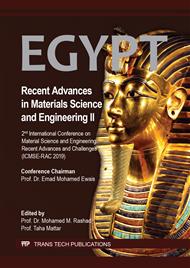[1]
M. S. Dresselhaus, and I. L. Thomas, Alternative energy technologies, Nature 414 (2001) 332-337.
Google Scholar
[2]
J. R. Bartels, B. P. Michael, and K. O. Norman, An economic survey of hydrogen production from conventional and alternative energy sources, Int. J. of hydrogen energy 35 (2010) 8371-8384.
DOI: 10.1016/j.ijhydene.2010.04.035
Google Scholar
[3]
A. A. El-Moneim, N. Kumagai, K. Asami, and K. Hashimoto, New nanocrystalline manganese-molybdenum-tin oxide anodes for oxygen evolution in seawater electrolysis, ECS Trans. 1 (2006) 491-497.
DOI: 10.1149/1.2215532
Google Scholar
[4]
A. A. El-Moneim, Mn-Mo-W-oxide anodes for oxygen evolution during seawater electrolysis for hydrogen production: effect of repeated anodic deposition, Int. J. of Hydrogen Energy 36 (2011) 13398-13406.
DOI: 10.1016/j.ijhydene.2011.07.100
Google Scholar
[5]
M. Culebras, C. Gómez, and A. Cantarero, Review on polymers for thermoelectric applications, Materials 7 (2014) 6701-6732.
DOI: 10.3390/ma7096701
Google Scholar
[6]
L. Wang, Y. Liu, Z. Zhang, B. Wang, J. Qiu, D. Hui, and S. Wang, Polymer composites-based thermoelectric materials and devices, Composites Part B: Engineering 122 (2017) 145-155.
DOI: 10.1016/j.compositesb.2017.04.019
Google Scholar
[7]
G. Chen, W. Xu, and D. Zhu, Recent advances in organic polymer thermoelectric composites." Journal of Materials Chemistry C 5 (2017) 4350-4360.
Google Scholar
[8]
Z. Fan, J. Yan, L. Zhi, Q. Zhang, T. Wei, J. Feng, M. Zhang, W. Qian, and F. Wei, A three‐dimensional carbon nanotube/graphene sandwich and its application as electrode in supercapacitors, Advanced materials 22 (2010) 3723-3728.
DOI: 10.1002/adma.201001029
Google Scholar
[9]
M. Gamil, O. Tabata, K. Nakamura, A. M. El-Bab, A. A. El-Moneim, Investigation of a New High Sensitive Micro-Electromechanical Strain Gauge Sensor based on Graphene Piezo resistivity, Key Engineering Materials 605 (2014) 207-210.
DOI: 10.4028/www.scientific.net/kem.605.207
Google Scholar
[10]
M. Gamil, H. Nageh, I. Bakrey, S. Sayed, O. Tabata, K. Nakamura, A. M. F. El-Bab, A. A. El-Moneim, Graphene-based strain gauge on a flexible substrate, Sensors and Materials 26 (2014) 699–709.
DOI: 10.1108/sr-07-2015-0114
Google Scholar
[11]
K. Xu, G. Chen, and D. Qiu, Convenient construction of poly (3, 4-ethylenedioxythiophene) –graphene pie-like structure with enhanced thermoelectric performance, Journal of Materials Chemistry A 1 (2013) 12395-12399.
DOI: 10.1039/c3ta12691a
Google Scholar
[12]
D. Kim, Y. Kim, K. Choi, J. C. Grunlan, and C. Yu, Improved thermoelectric behavior of nanotube-filled polymer composites with poly (3, 4-ethylenedioxythiophene) poly (styrene sulfonate), ACS nano 4 (2009) 513-523.
DOI: 10.1021/nn9013577
Google Scholar
[13]
L. Wang, Q. Yao, H. Bi, F. Huang, Q. Wang, and L. Chen, Large thermoelectric power factor in polyaniline/graphene nanocomposite films prepared by solution-assistant dispersing method, Journal of Materials Chemistry A 2 (2014) 11107-11113.
DOI: 10.1039/c4ta01541j
Google Scholar
[14]
Q. Yao, Q. Wang, L. Wang, and L. Chen, Abnormally enhanced thermoelectric transport properties of SWNT/PANI hybrid films by the strengthened PANI molecular ordering, Energy & Environmental Science 7 (2014) 3801-3807.
DOI: 10.1039/c4ee01905a
Google Scholar
[15]
S. Han, W. Zhai, G. Chen, and X. Wang, Morphology and thermoelectric properties of graphene nanosheets enwrapped with polypyrrole, RSC Advances 4 (2014) 29281-29285.
DOI: 10.1039/c4ra04003a
Google Scholar
[16]
L. Liang, C. Gao, G. Chen, and C. Y. Guo, Large-area, stretchable, super flexible and mechanically stable thermoelectric films of polymer/carbon nanotube composites, Journal of Materials Chemistry C 4 (2016) 526-532.
DOI: 10.1039/c5tc03768a
Google Scholar
[17]
M. Mitra, C. Kulsi, K. Chatterjee, K. Kargupta, S. Ganguly, D. Banerjee, and S. Goswami, Reduced graphene oxide-polyaniline composites—synthesis, characterization and optimization for thermoelectric applications, RSC Advances 5 (2015) 31039-31048.
DOI: 10.1039/c5ra01794g
Google Scholar
[18]
J. Xiang and L. T. Drzal, Templated growth of polyaniline on exfoliated graphene nanoplates (GNP) and its thermoelectric properties, Polymer 53 (2012) 4202–4210.
DOI: 10.1016/j.polymer.2012.07.029
Google Scholar
[19]
Y. Lu, Y. Song and F. Wang, Thermoelectric properties of graphene nanosheets-modified polyaniline hybrid nanocomposites by an in situ chemical polymerization, Materials Chemistry and Physics 138 (2013) 238-244.
DOI: 10.1016/j.matchemphys.2012.11.052
Google Scholar
[20]
R. A. Schlitz, F. G. Brunetti, A. M. Glaudell, P. L. Miller, M. A. Brady, C. J. Takacs, C. J. Hawker, and M. L. Chabinyc, Solubility-limited extrinsic n-type doping of a high electron mobility polymer for thermoelectric applications, Advanced materials, 26 (2014) 2825-2830.
DOI: 10.1002/adma.201304866
Google Scholar
[21]
B. Russ, M. J. Robb, F. G. Brunetti, P. L. Miller, E. E. Perry, S. N. Patel, V. Ho, W. B. Chang, J. J. Urban, M. L. Chabinyc, and C. J. Hawker, Power factor enhancement in solution-processed organic n-type thermoelectrics through molecular design, Advanced Materials, 26 (2014): 3473-3477.
DOI: 10.1002/adma.201306116
Google Scholar
[22]
M. Hirata, T. Gotou, S. Horiuchi, M. Fujiwara, and M. Ohba, Thin-film particles of graphite oxide 1:: High-yield synthesis and flexibility of the particles, Carbon 42 (2004) 2929-2937.
DOI: 10.1016/s0008-6223(04)00444-0
Google Scholar
[23]
E. C. Gomes, and M. A. S. Oliveira, Chemical polymerization of aniline in hydrochloric acid (HCl) and formic acid (HCOOH) media. Differences between the two synthesized polyanilines, Am. J. Polym. Sci, 2 (2012) 5-13.
DOI: 10.5923/j.ajps.20120202.02
Google Scholar
[24]
M. Mitra, K. Chatterjee, K. Kargupta, S. Ganguly and D. Banerjee, Reduction of graphene oxide through a green and metal-free approach using formic acid, Diamond Related Materials, 37 (2013) 74–79.
DOI: 10.1016/j.diamond.2013.05.003
Google Scholar


